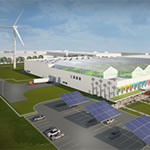In Chicago’s historic Pullman neighborhood, Method Products, the San Francisco-based maker of eco-friendly household cleaning supplies, will soon complete construction of a $30 million manufacturing plant that is aiming for LEED Platinum certification.
“Much of the environmental and social impact of a company such as ours lies in how we manufacture products, and our business has reached a size at which we have the ability to invest in our manufacturing for the first time,” says Method cofounder Adam Lowry.
The 150,000-square-foot facility, designed by William McDonough + Partners, also presents an opportunity for Method to manifest its business philosophy in a physical building that revitalizes an urban area and connects with the community—two things the organization cares about deeply.

Method’s wind- and solar-powered plant will create 100 manufacturing jobs in the city of Chicago.

Adam Lowry is the cofounder of Method Products.
When envisioning the facility, Method executives thought about the company’s values. “What is our role in society, and what role do we want our business to play in creating a more sustainable world?” Lowry and the executive team asked themselves. Those are big questions, which is why Method worked with one of the world’s top sustainable design firms.“ Bill McDonough and his team have the ability to take our vision and bring it to life in a way that meets our business requirements as well,” Lowry says. “It had to be reliable, flexible, and support our brand.”
In every aspect of the design, Method tasked McDonough + Partners with maximizing the same three things it maximizes with its business: social benefit, positive environmental impact, and financial benefit to company. Adding to the challenge, the building had to be in an urban area. “It would have been easier and cheaper to get a piece of land in a cornfield, but I didn’t want to do that, because we’re in the midst of a great historical migration into cities,” Lowry says. “But building in a city involved working with a brownfield site, which presented infrastructure challenges.”
McDonough + Partners ultimately had to start from less than scratch; the chosen site was the home of the abandoned Ryerson steel mill. The architects worked closely with the City of Chicago, the State of Illinois, and the federal government to make the project economically viable, but Roger Schickedantz, project manager at McDonough + Partners, defers much of the credit to Mayor Rahm Emanuel, who was eager to have the project built on the South Side of Chicago and “pulled out all the stops.”
Construction began in December 2013, and the building’s unique sustainable features are already taking shape. One of the most innovative, says Lowry, is a 1.5-acre rooftop greenhouse that is half the size of the building. Operated by a partner, it will grow hundreds of thousands of pounds of fresh, leafy greens sold to the community, in addition to shading the building. “Given our location on the South Side of Chicago, we’re asking that a certain amount of the produce go into the local community to deal with the food desert problem there,” Lowry says.

The facility will also be water-neutral, putting the water it uses back into the aquifer on a gallon-for-gallon basis.
Renewable energy will power the facility. A 230-foot, 600-kilowatt refurbished Rockwind wind turbine is expected to provide 55 percent of the building’s energy needs. An additional 60 kilowatts of energy will come from a solar array in the parking lot. That array, manufactured by Envision Solar, will take the form of three solar trees that move with the sun; each of the architecturally designed canopies will also shade six cars.
Materials are also sustainable. “Method came to us because 75 percent of its products are Cradle-to-Cradle certified at the gold level, and Adam wanted to bring that same thinking to the facility,” Schickedantz says. Although not all materials used in the facility are Cradle-to-Cradle certified, many were vetted by MBDC, which Method has been working with on Cradle-to-Cradle certification for its products.
Particularly significant to Lowry, the facility will also be water-neutral, putting the water it uses back into the aquifer on a gallon-for-gallon basis. “I’m a native son of the Great Lakes region, which is under water stress, so water is a particularly important issue for me,” says Lowry, who is currently working with Nature Conservancy on the pioneering program.
The facility, which is scheduled to open in early 2015 and manufacture 95 percent of Method’s products, will bring close to 100 manufacturing jobs to Chicago, and Method plans to recruit Pullman residents in the hiring process.

